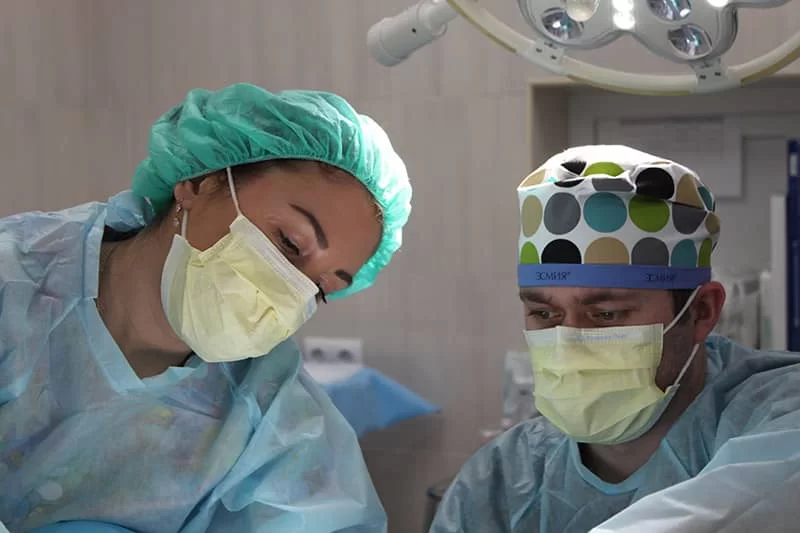In an era where digital presence is imperative, having a responsive website is no longer optional—it’s essential. At Constructive Visual,...

It is no secret that the healthcare industry is undergoing a digital transformation. More and more medical practices are realizing the need for a strong online presence, and as a result, the demand for medical website design services is on the rise.
If you are a doctor or own medical practice, it is important to have a website that looks professional and trustworthy. A Medical Website Design Agency can help you create a website that meets all of your needs and makes your practice look great. But how do you choose the right agency for you?
There are many different agencies out there, each with their own specialties and strengths. This guide will help you understand what to look for in a medical website design agency and how to choose the right one for your practice.

There are many benefits of having a medical website, including:
A medical website can save you a lot of time. With a website, you can post your medical information online so that patients can access it 24/7. This means you don’t have to spend time on the phone or in person answering questions about your practice. You can also use your website to schedule appointments and send patient reminders.
It also allows you to quickly communicate any changes in your practice or new services you may offer. Using a website to save time is a great way to maximize efficiency and ensure your doctor’s surgery runs smoothly. It can save time by reducing paperwork, scheduling appointments, and providing easy access to medical information. In addition, it can save valuable time by helping you stay informed about the latest news and trends in the medical field. With a website for your doctor’s surgery, you can save valuable time while still providing excellent patient care.
By having a Medical Website for your Doctors Surgery, you save yourself precious Time that could be spent on more critical tasks such as treating patients with all the necessary care they deserve!
A medical website can help reduce daily repetitive tasks for both doctors and patients. For example, a doctor can use a website to check a patient’s symptoms and medications and schedule appointments. Patients can use a website to request prescription renewals and refill their medications. In addition, a medical website can help reduce the number of phone calls a doctor’s office receives each day.
Patients can use the website to ask questions, receive answers to common inquiries, and schedule appointments without needing to call.
By using a medical website, doctors can reduce manual tasks that would otherwise eat up their valuable time. Doctors will have more time available to focus on providing quality care instead of spending it carrying out administrative duties. A good medical website will be easy to use and allow patients to quickly search for information, find a doctor that meets their needs, or request an appointment.
A medical website can also help to increase patient satisfaction. When patients are able to access your website, they will be able to learn more about your practice and what to expect when they come in for an appointment. They can also use your website to contact you with any questions or concerns. By providing patients with this information, you can help to ensure that they have a positive experience at your practice.
A medical website is also an excellent way for doctors to reach out to their community. Doctors can post educational materials about relevant health topics and share blog posts about their practice. Patients will be able to read up on these topics from the comfort of their homes, and be better informed when they come to the doctor’s office.
Finally, having an online presence allows doctors to increase their visibility in their community. Patients will be able to quickly search online for information about their doctor’s practice and contact them directly for appointments or questions. A professional-looking website will help attract new customers and build trust with current ones.
Maintaining a physical office for your medical practice can be expensive. You have to pay for rent, utilities, janitorial services, and furniture. Having a medical website can help reduce these costs by allowing you to communicate with your patients online and eliminating the need for a physical office space. You can also save on printing and postage costs.
With a medical website, your practice can offer services such as appointment booking and reminders, online payment solutions, and integrations with other systems. Many of these solutions allow you to streamline operations, eliminating tedious processes that take up valuable time. Automating appointment bookings and payments can help reduce paperwork and save staff hours. This is especially important for smaller practices that may not have the resources to employ multiple administrative staff members.
A medical website can help streamline your practice. By using a website, you can automate many of the tasks that are associated with running a medical practice. For example, you can use a website to send appointment reminders to patients and track their appointments. You can also use a website to manage your patient records and billing information.
Having a medical website also improves patient engagement by providing patients with access to information about their health 24/7 from any device. This helps build trust between your practice and patients, which in turn creates loyalty and encourages referrals. Patients can easily access important information on the website such as doctors’ profiles and services offered.
A website for your doctor’s surgery does not have to be expensive either. There are cost-effective solutions that help you create a professional-looking site without breaking the bank. Many of these solutions offer features such as drag-and-drop page design, content management systems, online payment solutions, and integrations with other systems at an affordable price point.
Overall, having a medical website is one of the most cost-effective ways to increase efficiency in your practice while providing improved patient engagement and satisfaction levels. Investing in a well-designed website will help improve patient recruitment rates, enable better communication, create a positive online presence and provide an overall higher level of service.
A medical website can also improve communication with patients. A website can post updates about your practice, including changes in hours or locations. You can also use your website to send out newsletters or announcements. Using a website, you can inform your patients about what is happening at your practice.
A website for your doctor’s surgery is essential for staying competitive in today’s market and making sure that patients get high-quality care every time they visit your practice. With the right cost-effective solution, you can create an attractive site that will make patients feel comfortable enough to trust your services while keeping them informed of your latest news and schedules.

When patients are looking for a new doctor or medical practice, they will want to choose one that is trustworthy and has a good reputation. You can use your medical website to show potential patients why they should choose you. Here are some tips:
Ensure that your website includes information about the quality of care you provide. You can do this by including testimonials from satisfied patients or by describing the procedures and treatments you offer. By showing potential patients that you provide high-quality care, you can convince them to choose you over other medical practices. It is important to remember that your website is often the first impression that potential patients will have of your practice.
In addition to providing information about the quality of care you provide, a medical website can also help to improve patient care by providing patients with access to resources and educational materials. For example, your website could include links to articles or videos that explain various health topics; this education can help patients better understand their condition and how best to manage it. Furthermore, display contact information and office hours prominently so that people can easily get in touch with you when they need assistance.
Your website is also an excellent way of increasing engagement among existing patients. You can use your website as a platform for communicating special promotions, events at the practice, or new developments in the field of medicine. By keeping current and potential clients informed about any changes or news relevant to your practice, you can foster trust and show that you value their patronage.
A medical website allows practices to streamline many of the traditional processes involved in patient care. Use technology to facilitate bookings with an online appointment system, reduce paperwork with digital forms, or even create a portal for patients to access their health records easily and securely. This improves convenience for both parties and reduces the administrative burdens on healthcare providers.
Make sure that your website includes information about how you communicate with patients. You can do this by describing your policies for returning phone calls and emails. You can also include a section on your website where patients can ask questions or leave comments. By showing potential patients that you are accessible and easy to communicate with, you can convince them to choose you over other medical practices.
It is also important that your medical website design includes a convenient appointment scheduling system for patients. This allows them to choose the time and date of their appointment without having to call or visit the office. A good scheduling system should be mobile-friendly so that it can be used while on the go.
Another way to provide better communication with patients through your medical website design is by including an online bill payment option. This will save both you and your patient time when they are paying their bills, as well as providing convenience in case they need to make a payment outside of traditional business hours.
If you offer lower costs for your services, be sure to include this information on your website. You can do this by listing the prices for your services or by providing coupons or discounts. By showing potential patients that you offer lower costs, you can convince them to choose you over other medical practices.
By following these tips, you can use your medical website to show potential patients that you are the right choice for their needs. With a little effort, you can create a website that will help you attract new patients and grow your practice.
Using cost-effective solutions for website building can save your practice money without sacrificing quality or function. By taking the time to research appropriate options, you can find a platform that meets the needs of your practice while staying within your budget. With budgets being tight across medical practices, it’s important to invest in cost-effective solutions when creating a doctor’s surgery website.

In order to attract new patients, it is important to have a strong social media presence. You can use your medical website to help you create and implement a social media strategy. Here are some tips:
The first step is to create social media accounts for your practice. You should create accounts on major social media platforms like Facebook, Twitter, and Instagram. Once you have created your accounts, you should populate them with content that will interest potential patients. This could include medical tips, advice about surgeries and medical procedures, or even just funny medical stories.
Creating social media accounts for your medical website will help you foster relationships with potential patients. You can use the accounts to answer patient questions, give medical advice, and post updates on upcoming surgeries or medical events. This will create a sense of trust with potential patients as they know that their medical provider is knowledgeable and willing to help them out when needed.
Another benefit of creating social media accounts for your medical website is increased visibility. By having an active presence on popular platforms like Facebook or Twitter, you will be able to reach more people and spread awareness of your practice.
It is important to post regularly on your social media accounts. You should aim to post at least once a day. When you are posting, you should include information about your practice, such as updates, news, and special offers. You should also post images and videos that will interest potential patients. Not only will this help you to build relationships with your target audience, but it can also be a great way to boost your medical website’s SEO.
Posting regularly on social media gives medical websites the opportunity to reach new audiences and drive more traffic to their medical website. With more followers, their posts are likely to be seen by more eyes, increasing their chances of engagement with potential patients. Also, when someone links directly from a post on a social media platform, this helps improve the website’s ranking on search engine results pages (SERP).
Medical websites can use targeted keywords in their posts. This can help them increase visibility for specific terms that users may be searching for, helping them reach more potential patients. Additionally, medical websites can also use social media platforms as a platform to connect with their existing followers and build relationships with them.
By building relationships on social media networks, medical websites are able to create trust amongst potential patients and encourage engagement with your medical website. Ultimately, this will result in more clicks and visits to the medical website which can lead to more successful conversions from visitors into paying customers or clients.
When you are creating your social media strategy, you should keep in mind the needs of your practice. You should consider the size of your practice, your budget, and your goals. By considering these factors, you can create a social media strategy that will help you attract new patients and grow your practice.
The first step for your medical practice should be to develop a medical website. A well-designed medical website can help you reach new patients and communicate with them quickly and efficiently. Your medical website should include information about your services, contact information, and an FAQ section. Once you have built a medical website, you can begin promoting it on social media platforms such as Twitter, Instagram, and Facebook.
Social media is one of the best ways to grow your medical practice’s presence online. You can share content from your medical website or create engaging posts that will draw attention to your practice and its services. You can also use social media ads to target potential patients who are looking for medical care in your area.
Your medical website is a powerful tool that can help you attract new patients and grow your practice. It should be easy to navigate and include all the information that patients would need. In addition, your website should be mobile-friendly so patients can access it from their smartphones or tablets. Besides being user-friendly, your website should also be aesthetically pleasing. Patients will be more likely to choose a medical practice that has a professional website.
Social media is an important part of medical practice marketing and outreach. It can help you engage with your current patients, find new ones, and build relationships with other medical professionals in the field. Leveraging the power of social media requires a well-thought-out strategy that includes regular posts on major networks such as Facebook and Twitter. You should also include calls to action in your posts to encourage patients to take action (e.g., book an appointment, or request more information).
Having a medical website that is designed with social media in mind will help ensure that all your outreach efforts are effective. Make sure that it allows for easy sharing of content across multiple channels and platforms. Also, consider adding links back to your website from social media posts, which can help to increase your website’s presence and visibility.
Using medical-specific visuals whenever possible in order to make a strong impression on potential patients. Your medical practice should also have an active blog where you post medical advice and news about the latest medical advancements. This will not only show that you are up-to-date with medical trends, but will also attract more visitors who may be interested in learning more about the services that your practice offers.
Make sure that your medical website has clear calls to action and that all relevant contact information is clearly displayed. Doing this will ensure that viewers know exactly how they can get in touch with you for further questions or to schedule appointments.
Your website should also include professional website copy. This means that your website should be free of errors and typos. In addition, your website copy should be well-written and persuasive. By including professional website copy, you can show potential patients that you are a credible source of information.
A copywriter can help you to ensure that your medical website is professional and well-written. When you hire a copywriter, they will have a professional approach to creating the content for your medical website. This means that they understand what type of words and phrases will be most effective in reaching potential patients and communicating the information on your medical website.
Moreover, a medical copywriter can provide you with SEO-friendly content. Search engine algorithms focus on keywords when ranking websites, so including relevant keywords in your medical website’s copy can help to increase its visibility online. Additionally, an expert copywriter will use certain strategies such as internal linking and meta tags within their content to further enhance the SEO value.
The user experience is the most important factor to consider when designing your website. Your website should be easy to navigate and include all the information that patients would need. In addition, your website should be mobile-friendly so patients can access it from their smartphones or tablets. Besides being user-friendly, your website should also be aesthetically pleasing. An attractive website design not only makes it easier for patients to use but also helps create a positive first impression.
When designing your medical website, careful consideration should be given to the various features that are important to users. A search function is essential so patients can quickly find the information they need. For example, if they’re looking for information about a particular procedure or condition, they should be able to easily find it on the site. In addition, having access to appointment scheduling or patient forms is also very helpful and can save time for both the patient and staff members.
The content of your medical website is equally important as its design and functionality. Patients should be able to find all relevant information in one place including details about services, fees & payment, and any relevant forms or applications. Clear and concise writing is also essential to ensure that visitors can quickly comprehend the information you are providing on your medical website.
Intuitive website navigation should be easy for users to understand. If a patient can easily find what they need without confusion, it will help create a positive experience and increase the likelihood of them returning in the future.
Making sure that your medical website has great user experience (UX) will not only improve their overall satisfaction but may also lead to more conversions such as appointments booked or forms filled out. In today’s competitive landscape, having a well-designed medical website with great UX is essential for achieving success online.
It is important to build trust with potential patients. You can do this by including testimonials from satisfied patients on your website. In addition, you should include information about your qualifications and experience. Building trust with potential patients can convince them to choose you over other medical practices.
Showing medical authority on your website is also important. You can do this by including medical references and studies that support the services you offer. This will demonstrate to patients that you are knowledgeable and experienced in your field, which can increase their confidence in your practice.
Having a professionally designed website can also help to build trust with potential patients. A website that has been properly designed should be easy to navigate, visually appealing, and informative. It should provide potential patients with a clear idea of what services you offer and why they should choose you over other medical practices.
By taking the time to create a well-designed medical website, you will be able to show potential patients that you value quality and professionalism. By building trust through a website, you will be able to establish a good reputation and encourage people to take advantage of the medical services you offer.
In addition to having a well-designed website, there are other ways that medical professionals can show their medical authority on a website. For example, showcasing awards or certifications, displaying patient reviews or testimonials, and providing detailed information about your medical qualifications. By doing this, you will be able to demonstrate your medical expertise in an organized and transparent way.
Having a clear understanding of how to build trust with patients through a website is essential for medical professionals who want to attract new patients and strengthen relationships with current clients.
Creating a medical website that is mobile-friendly offers numerous advantages to medical organizations. For starters, it increases the visibility of your medical practice on search engines, which can help you attract new patients and grow your business. Mobile medical websites also improve patient engagement, as patients are more likely to use their smartphones or tablets for medical information rather than relying solely on desktop computers. Your website should be responsive so that it can adjust to different screen sizes.
Mobile-friendly medical websites provide a better user experience by making it easier for patients to access vital health information quickly and conveniently from any location. Having a mobile-friendly medical website ensures that your website will be properly optimised for various types of devices so that users have an optimal viewing experience no matter what device they use.
Mobile medical websites make it easier for users to access vital health information quickly and conveniently from any location, including medical offices or waiting rooms. A responsive medical website design can help improve search engine rankings, making it easier for potential patients to find you online.
Finally, having a mobile medical website allows healthcare providers to keep up with changing trends in technology so they can remain competitive in today’s digital landscape.

It’s no secret that building trust is essential to attracting new patients and growing your medical or health practice. But what’s the best way to go about it? One of the most effective ways is ensuring your website features professional copywriting.
This means making sure there are no errors or typos and that the overall tone is persuasive yet respectful. In addition, including testimonials from happy patients can be helpful in boosting your credibility.
Keep all of this in mind as you work on building trust with potential patients – it’ll pay off in the long run!
When potential patients search for medical services online, they typically turn to Google. This is why it’s important to ensure your website appears as high up in the search results as possible.
On-Page Optimisation is a solid way to make this happen. This is the process of ensuring your website’s code and content are optimized for Google’s search algorithm. In-depth keyword research is also key in this process.
Ultimately, by taking the time to optimize your website for Google, your website will appear higher in the search results, making it more likely that potential patients will find and choose your medical practice.
When it comes to medical website design, SEO is even more important. Rather than relying on aesthetics alone, medical website owners need to make sure the content and code of their websites are SEO-friendly. This means using relevant medical keywords throughout content and tagging images correctly so they can be indexed by Google’s algorithms.
Medical websites should include essential components such as meta descriptions and page titles that contain medical keywords in order to rank higher in search results. By investing some time into optimizing a medical website for SEO, medical practices can enjoy improved visibility on search engines like Google. Not only will this increase traffic to the website, but it will also encourage potential patients to choose your medical practice over competitors.
Most customers looking for a medical website design agency will have some questions. You want to make sure the agency you choose has excellent customer support. This way, if you ever have any questions or concerns, you can easily get in touch with someone who can help. So, make sure your website design agency has a customer support team that is responsive and helpful.
At medical surgeries, customer support is paramount. You need to have confidence that any issues or queries you have can be quickly and efficiently resolved. You also want to know that if there are ever any problems with your website design, the agency will be able to fix them in a timely manner. A great customer support team ensures this happens by providing helpful advice and guidance when needed.
Having an excellent website agency with good customer support can give medical surgeries the edge they need when it comes to communicating with their customers online. Not only does it ensure potential patients browsing online get all the information they need, but it allows medical surgeries to provide better service for existing patients as well as new ones.
Your medical website design agency should also offer a clinic app. This mobile app allows patients to book appointments, view test results, and contact your practice. By offering a clinic app, you can make it easier for patients to access your practice. In addition, the clinic app can help you attract new patients to your practice.

Online booking is a convenient way for patients to schedule appointments. Your medical website design agency should offer online booking so patients can easily book appointments with your practice. By offering online booking, you can make it easier for patients to see you and choose your practice over other medical practices.
Online booking systems can help medical practices save time, money and resources. Patients don’t have to wait for your staff to answer their calls and book an appointment, they simply log onto the website and do it themselves. This means you won’t need as many staff members devoted to dealing with phone calls and manually booking appointments.
An online booking system also allows medical practices to send automated reminders that patients are due for an appointment. This helps ensure that patients keep their scheduled appointments and reduces no-show rates.
Finally, offering online booking on your medical website design gives you more control over how your practice runs. You can customise the process by setting up rules such as what types of appointments are available when they’re available, and how many days in advance they can be booked. This helps medical professionals keep their practice running smoothly and make sure that no appointment slots are wasted.
Overall, having an online booking system on your medical website design is a great way to increase efficiency, reduce missed appointments, and give you more control over the way your medical practice operates. It’s an essential tool for any medical professional looking to provide their patients with the best possible care.

Now that you know what to look for in a medical website design agency, here are five best practices for medical web design:
A professional medical website design agency will have experience designing websites for medical practices. They will understand the needs of your practice and design a website that meets those needs. They will also be able to help you create a website that is optimized for search engine visibility, helping to bring more traffic to your practice. Furthermore, they can develop and design a medical website that complies with Australian Web Content Accessibility Guidelines (WCAG) and other standards.
A professional medical web design agency can provide you with an eye-catching website that is easy to navigate, secure and aesthetically pleasing. A well-designed medical website can make it easier for patients to find important information about your practice, such as office hours and location information. It can also help build trust between potential and existing patients by giving them access to online appointment booking and the latest medical information.
Finally, creating your websites yourself takes time, energy, and resources that might be better spent caring for your patients. Hiring a professional medical web design agency can reduce the amount of time and stress you put into managing your website, freeing up valuable time to focus on more pressing matters.
By hiring a professional team of experienced web designers, you are guaranteed to have an engaging website that is easy to navigate and secure. We know how important it is for medical practices to effectively communicate with potential and existing patients online. That’s why we create websites that are optimized for both users and search engines to ensure that your website stands out from the competition.
Medical websites that are mobile-friendly ensure that your medical practice is accessible to users regardless of their device. Whether they’re accessing your website from a desktop, laptop, tablet or smartphone, patients will be able to interact with your medical website easily and without hassle.
When it comes to medical websites or any type of business website for that matter, responsive design is key. Responsive web design is the process of creating a medical website that automatically adjusts its layout and content depending on the device the user is using. This ensures visitors have an optimal viewing experience while providing easy navigation and access to relevant information regardless of their device.
With mobile-friendly medical websites provided by professional medical web designers, you can guarantee that your medical practice is providing a modern, easy-to-navigate medical website for your potential patients and clients. This is especially important in medical fields because the medical industry is always changing, requiring medical websites to be updated often. Responsive medical web design allows medical professionals to provide their users with up-to-date information while still ensuring they can access the website and its content easily on any device.
Additionally, mobile-friendly medical websites also increase search engine ranking. Google rewards mobile-friendly websites by offering them higher priority rankings in their searches compared to non-mobile sites. This means that when people are searching for medical services, it’s more likely your website will appear at the top of the search results if you have a mobile-friendly version.
Having an engaging medical website design is important to capture and retain patients, develop relationships and build trust. But without high-quality images, your medical website will not stand out and won’t bring you the results that you need. Professional photos are an essential part of medical website design, as they create a positive first impression while also communicating professionalism and credibility.
Professional photographers have technical know-how and experience in creating high-quality images tailored to medical websites. They can help communicate a message through a visual composition that authentically represents your brand or practice. This ensures that the imagery used on your medical website creates a powerful impact on visitors.
Using professional photographs for medical websites also gives them a polished look which makes it more likely that visitors will remember your medical website and come back to it. Professional photographers can also provide stock images or create custom images specifically for medical websites.
Ensuring that the photographs on medical websites are of high quality and align with the message you’re trying to convey is essential in creating a successful medical website. Using professional photographers helps to ensure this quality, as well as helping medical websites look more credible and trustworthy.
Overall, professional high-quality images are an integral part of medical website design and can give medical websites a distinct edge over their competitors by providing compelling visuals that communicate professionalism, quality, and trustworthiness.
Are you looking for a medical website design that goes beyond the basics? One of the most important elements to consider is including calls to action (CTAs). CTAs are an essential part of medical website design, as they tell visitors exactly what you want them to do. With a well-crafted CTA, you can direct potential clients down the path toward conversion and ensure your medical website succeeds.
A call to action button should be clearly visible on every page of your medical website – preferably in multiple locations so it stands out. Your call to action could be something as simple as scheduling an appointment or signing up for your newsletter. Remember, make sure any call to action is unique and relevant; don’t just rely on generic phrases like “Click Here”.
Creating persuasive call-to-actions isn’t always easy, but it’s essential for medical website success. Consider using power words like “Discover” or “Unlock” that draw attention to your call to action and make it more compelling. You can also use action verbs such as “Learn More” or “Download Now” to create a sense of urgency and encourage potential clients to take action right away.
Design is also key when it comes to creating effective medical website calls to action. Make sure your call to action stands out by using contrasting colours, text sizes, and fonts, with plenty of white space surrounding the button itself. Careful placement is important too – Call-to-actions should be placed in strategic locations on your medical website, such as above the fold or near important information. This will draw attention to the CTA and increase conversions.
When crafting medical website calls to action, think about what you are offering users, and make sure it is clear and concise. Keep your message simple but persuasive, so that visitors know exactly what they need to do to get started. Additionally, try testing different versions of your CTA with A/B split testing in order to see which ones perform better overall. By taking these steps, you can ensure that every medical website call to action leads to more conversions and a successful medical practice online!
Medical website SEO is essential for medical practices seeking to stand out in the digital landscape and grow their patient base. By investing in medical website design and Search Engine Optimisation (SEO), medical practices can ensure that their website appears at the top of search engine results, allowing them to tap into a much larger audience than they could otherwise reach.
Effective medical website SEO requires an understanding of how search engines work, as well as a comprehensive approach to optimising websites for both organic and paid search traffic. This includes creating compelling content that is relevant to target audiences, building internal links between webpages, and utilising targeted keywords throughout your website’s content.
Additionally, investing in social media campaigns and other online marketing initiatives will help boost the visibility of medical websites. By creating a strong online presence and staying active on social media channels, medical practices can reach more potential patients and build relationships with them.
By taking a comprehensive approach to medical website SEO, medical practices will be able to reach their target audiences more effectively. Investing time and effort into SEO will ensure medical websites get found by the right people at the top of the search engine results. With the help of medical website design and expert Search Engine Optimisation, medical practices can effectively reach their target audiences and improve patient engagement.
Make sure to invest in medical website SEO today to get the most out of your medical practice’s online presence! This is a great way to build relationships with potential patients and maintain a strong reputation for your medical practice. Investing in medical website SEO will help ensure that you stay at the top of the search engine results so that you can reach more people and grow your medical practice.
There are many medical website design companies to choose from. To find the best one for your practice, follow these tips:

When designing medical websites, it’s important to consider the customer’s pain points. Patients need easy navigation, so your medical website should be organized in a way that is intuitive and clearly laid out. Additionally, include a search bar for customers to quickly find the information they are looking for.
Another common issue patients face is not being able to contact the practice easily. To avoid this frustration, be sure to prominently display your contact information on your medical website including phone number, email address, and physical address. That way patients can get in touch with you quickly when they have questions or concerns.
Having a medical website designed with customer needs in mind makes it easier for both parties: practices don’t have to spend time responding to patient inquiries, and customers don’t have to search high and low for the information they need. With medical website design, consider what patients need and make sure your site meets those needs. By providing easy access to important information, you can reduce customer pain points while saving time and effort on both sides.
By taking into account customer pain points when designing a medical website, practices will be able to create an effective digital presence that is not only helpful but user-friendly as well. Making it easy for people to find what they are looking for and having contact information readily available goes a long way in ensuring satisfactory experiences with medical websites.

There are many benefits of advertising on medical websites. Here are a few:
You can target a specific audience with medical website advertising. For example, you can target people in your city or state who are searching for a “family doctor“. Additionally, you can target people who have previously visited your website.
By targeting a specific audience, you’re more likely to get leads from potential patients who are interested in what you offer.
Organic traffic is the type of website visitor that comes to your medical website without any advertisement or promotion. It represents visitors who are actively searching for something related to your medical practice, such as medical advice and services and have reached your site through organic search engine results. Organic traffic can greatly benefit a medical website, as it provides the opportunity to increase visibility and gain potential patients.
Organic traffic can be gained in various ways by leveraging medical website design, strategic content writing, and SEO optimization techniques. By optimizing all elements of medical website design including page layout, image placement, navigation, content structure, etc., you will increase the chances of people finding your medical website through organic searches.
Additionally, creating fresh content on topics related to your medical practice and writing compelling blog posts, articles, or reviews that are SEO-friendly can also help increase organic traffic. With medical website advertising, you have the ability to reach potential patients beyond organic search results. By using a combination of medical website design and medical website advertising, you can create an effective strategy to drive more people to your medical website and subsequently increase your patient base.
By leveraging medical website design and medical website advertising, you can gain more visibility among potential patients and generate higher-quality leads for your medical practice. Through creating engaging content with strategic keywords, optimizing page layout and navigation elements on your medical website, as well as utilizing medical website advertising platforms such as Google Ads or Facebook Ads – you’ll be able to attract more people to your website and increase organic traffic.
Organic traffic is the stream of visitors to your medical website who find you through online search engine results without you having to pay for their visit – as opposed to paid visits or advertisement clicks. To maximize organic traffic, medical website design should be optimized with quality content that is both engaging and relevant to users’ queries, keyword research should be utilized to determine which words will generate the most interest among potential patients, and medical website advertising strategies should be used in order to target relevant audiences.
By investing in medical website design, targeted medical website advertising campaigns, and optimizing key elements on your medical website for organic traffic – such as page titles and meta descriptions – you can create an effective strategy for driving more visitors and customers to your medical practice.
Organic traffic is a type of website traffic that comes from search engines such as Google, Yahoo, Bing, or other online sources without any direct advertisement or promotion. Organic traffic is determined by the relevance of the content that appears on medical websites and can be increased through effective medical website design and medical website advertising campaigns. By ensuring your medical website has quality content that is relevant to queries users are searching for, you can increase organic traffic. Additionally, utilizing keyword research can help you determine which words will generate the most interest among potential patients when they search for medical services.
Advertising on medical websites can be an effective way to reach a large audience and maximize website traffic. With medical website design, you have the potential to reach people who are specifically interested in medical topics, giving your ad greater visibility and increasing the chances of success.
Medical-related websites typically receive high amounts of traffic due to their relevance and popularity. By advertising on medical websites, you’re tapping into this existing user base with a targeted promotion that will bring more attention to your business. This can also help differentiate your brand from competitors as it shows an understanding of the industry and its needs.
Advertising on medical websites is a great way to gain exposure for your business while reaching new customers who might not have otherwise found out about you and drive traffic to your website.

There are many website design companies to choose from. Here is a list of some of the best:




These are just a few of the many website design companies to choose from. When selecting a website design company, be sure to look at their portfolio and read online reviews.
Additionally, get a quote from each company you’re considering to ensure you’re getting the best value for your money.






Nearly 20 percent of Australians have a disability. This means medical websites need to be designed with accessibility in mind. The Australian Web Content Accessibility Guidelines (WCAG) provides a set of standards and principles that medical websites must adhere to in order to ensure they are accessible to people with disabilities.
WCAG standards are based on international best practices and include web page design, content structure, navigation, readability, keyboard navigation, video use and more. By adhering to the WCAG guidelines medical websites will provide an accessible experience for all users regardless of their disability or physical ability.
This not only benefits those who have a disability but also helps medical professionals reach out to a broader range of patients and provides an equal access platform for everyone including those from different cultures and backgrounds. A medical website should be designed with accessibility in mind, and WCAG standards can help medical professionals achieve this.
WCAG guidelines are comprehensive and comprehensive medical website designs should be tailored to meet the needs of those with disabilities. This includes providing clear navigation for wheelchair users, large fonts for people with low vision, audio options for deaf or hard-of-hearing individuals and more. Furthermore, medical websites should make use of appropriate alternative text descriptions so that those using screen readers can understand the content without having to rely on images alone.
Adhering to Web Content Accessibility Guidelines not only helps medical websites become accessible but also provides medical professionals with a greater level of trust from their patients.
A medical website should have several essential pages to ensure a comprehensive online presence and attract prospective patients. These pages include:
1. Homepage – This is the first page of your medical website, so it should be designed to give an overview of the practice, its staff members and services offered. The home page should also feature contact information for potential new patients who want to make an appointment or ask questions.
2. About Us – This page tells visitors about the practice’s history and team members, as well as any awards or recognition that it may have received. It can also showcase patient testimonials and highlight special programs or initiatives supported by the clinic.
3. Services / Procedures – Visitors will come to this page to learn more about the treatments and services offered by the practice. This could include a list of specialized medical procedures, surgical options, preventative care and wellness programs.
4. Patient Forms – There should be an easy way for patients to access all the forms they need prior to their appointment. These can range from consent forms, insurance information or new patient paperwork.
5. Insurance Information – Providing detailed information on accepted insurance plans is important in helping potential patients make informed decisions prior to scheduling an appointment.
6. Contact Us / Location & Hours – The contact page should include a map of the location along with directions and hours of operation in order to be easily accessible for those looking for additional information or booking an appointment.
7. Forms – In order to make the check-in process more efficient, it’s important for medical website designs to include forms that patients can complete prior to their visit. This includes consent forms, medical history, insurance information and other new patient paperwork.
8. Appointment Request / Scheduling – To reduce wait times and improve patient satisfaction, providing an online scheduling system is essential for modern websites.
9. FAQs – Common questions related to the medical practice and available services should be included on the website in order to provide quick answers to visitors who may have additional inquiries about their care options.
10. Blog / Articles – A blog or articles section helps highlight the expertise of the practice and provides a platform for delivering helpful information to patients.
11. Online Shop – Many medical practices now sell products online, such as nutritional supplements or over-the-counter medications. A dedicated page on the website should be used to display items and manage orders.
12. Patient Portal – For practices looking to provide more comprehensive patient care, an interactive portal can give patients secure access to their records, appointments and additional resources that are relevant to their health needs.
By creating these 12 essential pages, medical websites will have all of the core components needed in order to attract new patients and support existing ones through the digital experience.
Are you thinking about creating a medical website for your medical practice but aren’t sure how long it will take? We know that getting online can seem like a daunting task and the last thing you want is to be waiting weeks before your medical website goes live.
At Constructive Visual, we understand your concerns and will work with you every step of the way to ensure that the process of building your medical website runs as smoothly and quickly as possible. With our expertise in medical website design, we strive to deliver results within 4-6 weeks from content provided and client approval on pages.
We have experience in building websites and can create a professional website for your medical practice that meets all of your needs. We provide all the necessary resources and tools to get your website up and running as quickly as possible.
We understand medical practices have a lot of demands on their time, and that’s why our medical website design process is designed to be efficient and stress-free. We will work with you every step of the way to ensure that the process goes smoothly and quickly.
From start to finish, we guarantee quality results in the shortest turnaround time possible. Contact us today for more information about how we can help create an amazing medical website for your practice!
Yes, you will be able to make changes to the website once it’s live. You will have access to a control panel where you can edit text, add/delete pages, and change the look of the site.
Making changes is easy and does not require any HTML knowledge. If you need help, our support team is always available to assist you.
Now that you understand the basics of what to look for in a medical website design agency, it’s time to start your search. Use the tips we’ve shared to create a shortlist of agencies that fit your needs, and then reach out for quotes. Don’t be afraid to ask questions; a good agency will want to get to know your practice and understand your goals. And finally, remember that this is an investment in your business.
A well-designed website can help you attract more patients, increase revenue, and establish yourself as a leader in your field. Are you ready to take your practice online? If so, contact one of our experts today and let us show you how easy and affordable the website
Loved this article? Please consider sharing it with your friends…

Peter Lowen
Senior Web Developer | CEO
Peter Lowen is the founder and CEO of Constructive Visual, a website design and hosting company. He has been creating websites since 2005 and writes content on business, marketing, web design, sales training, web hosting and WordPress related topics.
Responsive Web Design – Best Practices for a Responsive Website
In an era where digital presence is imperative, having a responsive website is no longer optional—it’s essential. At Constructive Visual,...
The Crucial Role of a Business Website in Elevating Your Brand
In a competitive industry, the success of a business often hinges on its online presence. As consumers increasingly turn to...
Strengthen your Perth & Wheatbelt business’s online presence with tailored website design and hosting, raising visibility, enhancing user experience, and...
Branding is essential for any business, big or small. It helps to create a unique identity and sets you apart...

We are an SEO & web design agency located in Northam, Western Australia.
Address: PO Box 985,
Northam WA 6401
Location: Perth, Western Australia
Phone: (08) 6118 9186
Email: Contact Us
Services
Information




